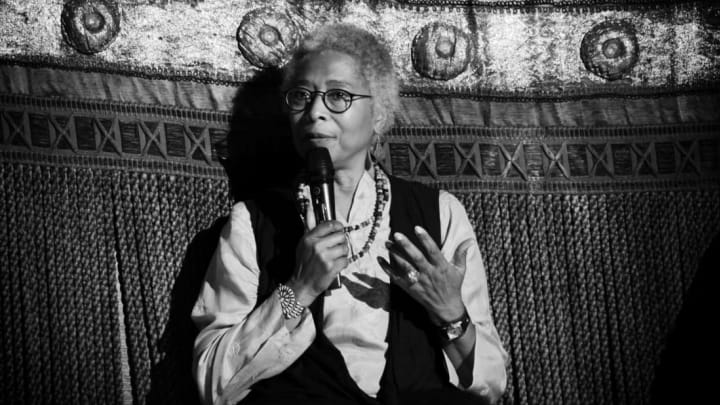10 Things You Might Not Know About Alice Walker

Bestselling author Alice Walker is best known for her 1982 novel, The Color Purple, which made her the first Black author to win a Pulitzer Prize and a National Book Award for Fiction. But she is also an accomplished poet and non-fiction writer with a large body of critically acclaimed literary work. Here are a few things you might not know about Alice Walker.
1. Alice Walker has multiple middle names.
Walker’s full name is Alice Malsenior Tallulah-Kate Walker. She added her second middle name to honor her grandmother Kate Nelson and great-grandmother Tallulah Calloway.
2. Alice Walker’s parents supported their daughter's writing.
Alice was the youngest of eight siblings. Her parents were sharecroppers in rural Georgia, and they were determined that none of their children would work in the fields.
3. Alice Walker was blinded in one eye.
When she was 8 years old, Walker was accidentally shot in the eye by a brother playing with his BB gun. Her injury was so severe that she lost the use of her right eye.
4. Alice Walker was an excellent student.
Walker was the valedictorian of her high school and went on to attend Spelman College and Sarah Lawrence College. While studying at Spelman College, a Historically Black College (HBCU) in Atlanta, Walker won a scholarship to study in Paris. She turned it down to go instead to Mississippi, where she joined the civil rights movement after meeting Martin Luther King, Jr.
5. Alice Walker’s first published essay won $300.
When she was 23, Walker’s essay about her time advocating civil rights, “The Civil Rights Movement: What Good Was It?,” won The American Scholar’s essay contest in 1967 and later appeared in the magazine. It was her first published work.
6. The Color Purple is Alice Walker’s best-known book.
Walker’s 1982 novel portrays a Black Southern woman’s rocky journey toward self-empowerment. While it became a bestseller and is widely read in high school English classes, The Color Purple is often challenged and banned in school districts due to its explicit sexuality and language.
7. The Color Purple film adaptation was a box-office smash.
The Steven Spielberg-directed drama, starring Whoopi Goldberg as the protagonist Celie and Oprah Winfrey as her friend Sofia, was released in 1985 and went on to become a box-office success, staying in U.S. theaters for 21 weeks and grossing more than $142 million worldwide. Winfrey, in her first film role, and Goldberg, in her second, both received Academy Award nominations for their performances. When Spielberg completed shooting the movie, he gave Walker a painting, Man on White, Woman on Red , by the African-American artist Bill Traylor. The painting was recently auctioned for $507,000.
8. The 1985 movie of Alice Walker’s novel led tp a Broadway musical and another movie.
In 2005, The Color Purple was turned into a Tony Award-winning musical on Broadway and ran for three years. Spielberg, Winfrey, and music producer Quincy Jones are now producing a new movie musical treatment for Warner Bros. As reported by The Hollywood Reporter, playwright Marcus Gardley (The House That Will Not Stand) will pen the script, and Blitz Bazawule (Black Is King) will direct.
9. Alice Walker’s marriage broke barriers.
Walker met her now ex-husband, human rights lawyer Melvyn Leventhal, when they both worked in the civil rights movement in Mississippi. When they married in 1967, they became the first legally married interracial couple in the state. They had one daughter before divorcing in 1976.
10. Alice Walker rediscovered another Black writer.
In 1973, Walker and scholar Charlotte D. Hunt rediscovered the unmarked gravesite in Fort Pierce, Florida, of writer and anthropologist Zora Neale Hurston, author of the classic novel Their Eyes Were Watching God. Hurston had died in obscurity in 1960, and Walker had the gravesite properly marked. When Walker became a contributing editor at Ms. magazine, she published "In Search of Zora Neale Hurston" about the experience, resulting in renewed appreciation of Hurston’s work.